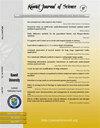Seismic site characterization of Malang Regency (Indonesia) using HVSR inversion
IF 1.1
4区 综合性期刊
Q3 MULTIDISCIPLINARY SCIENCES
引用次数: 0
Abstract
Based on Indonesia's active fault map, this study focuses on the Eurasian and Indo-Australian plate subduction zone in the southern sea of Java, an area that is highly susceptible to earthquake risk and soil vulnerability. This study aims to determine soil vulnerability based on average shear wave velocity of the top 30 m (Vs30) and sediment thickness (z1.0) parameters to map areas at risk of earthquake in the study area. From both parameters, the most vulnerable and safest area in Purwodadi Village, Indoensia will be determined. The method used in this research is microtremor measurement with a portable miniature broad band (MBB-2) seismograph. Measurements were conducted at 19 points spaced approximately 500 m apart. Horizontal vertical spectral ratio (HVSR) inversion was applied to obtain shear wave velocity profiles at each point. Soil assessment was performed using Vs30 parameters, classified according to the American society of civil engineers (ASCE) standards. The results show that areas with relatively high earthquake vulnerability, indicated by low Vs30 values, are located near measurement points RKI08 and RKI18 in residential areas and RKI04 on slopes with Vs30 values are 219.0 m/s, 248.9 m/s, and 230.2 m/s respectively. Besides that, these points have high z1.0 value, these values are 388.0 m, 517.8 m, and 46.6 m respectively. Meanwhile, areas with lower vulnerability are found at RKI10 and RKI09 in residential areas and RKI05 on slopes, with Vs30 values are 502.0 m/s, 481.1 m/s, and 416.0 m/s respectively. These points have Vs30 values classified as “very dense soil” and have low z1.0 values (60.3 m, 109.6 m, and 43.9 m respectively). Based on data processing, there is a fault that stretches straight from RKI04, RKI11, to RKI14. However, more research needs to be conducted using alternate methods to confirm the existence of the fault. This mapping is expected to provide local authorities valuable input for disaster mitigation planning.
利用HVSR反演反演印尼玛琅县地震场特征
基于印度尼西亚的活动断层图,本研究将重点放在爪哇海南部的欧亚和印澳板块俯冲带,这是一个高度易受地震风险和土壤脆弱性影响的地区。本研究的目的是通过地表30 m平均横波速度(Vs30)和沉积物厚度(z1.0)参数确定土壤易损性,绘制研究区地震危险区域图。根据这两个参数,将确定印度尼西亚Purwodadi村最脆弱和最安全的地区。本研究采用便携式微型宽带(MBB-2)地震仪测量微震。测量在相隔约500米的19个点进行。利用水平垂直谱比(HVSR)反演得到各测点的横波速度剖面。采用Vs30参数进行土壤评价,按照美国土木工程师学会(ASCE)标准进行分类。结果表明,地震易损性较高的地区位于居民区RKI08和RKI18测点附近,位于Vs30分别为219.0 m/s、248.9 m/s和230.2 m/s的斜坡上RKI04测点附近,Vs30值较低。此外,这些点的z1.0值较高,分别为388.0 m、517.8 m和46.6 m。民居区RKI10、RKI09和斜坡区RKI05的Vs30值分别为502.0 m/s、481.1 m/s和416.0 m/s,脆弱性较低。这些点的Vs30值被归类为“非常致密的土壤”,z1.0值较低(分别为60.3 m, 109.6 m和43.9 m)。根据数据处理,在RKI04、RKI11、RKI14之间存在一条断层。然而,需要使用替代方法进行更多的研究来确认故障的存在。预计绘制地图将为地方当局提供减灾规划方面的宝贵投入。
本文章由计算机程序翻译,如有差异,请以英文原文为准。
求助全文
约1分钟内获得全文
求助全文
来源期刊

Kuwait Journal of Science
MULTIDISCIPLINARY SCIENCES-
CiteScore
1.60
自引率
28.60%
发文量
132
期刊介绍:
Kuwait Journal of Science (KJS) is indexed and abstracted by major publishing houses such as Chemical Abstract, Science Citation Index, Current contents, Mathematics Abstract, Micribiological Abstracts etc. KJS publishes peer-review articles in various fields of Science including Mathematics, Computer Science, Physics, Statistics, Biology, Chemistry and Earth & Environmental Sciences. In addition, it also aims to bring the results of scientific research carried out under a variety of intellectual traditions and organizations to the attention of specialized scholarly readership. As such, the publisher expects the submission of original manuscripts which contain analysis and solutions about important theoretical, empirical and normative issues.
 求助内容:
求助内容: 应助结果提醒方式:
应助结果提醒方式:


